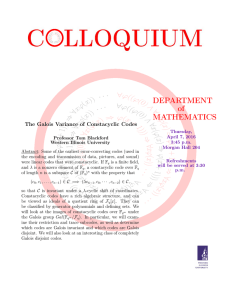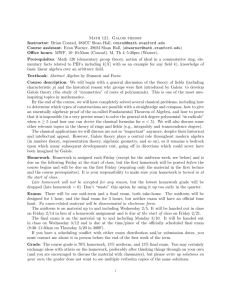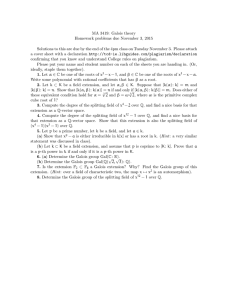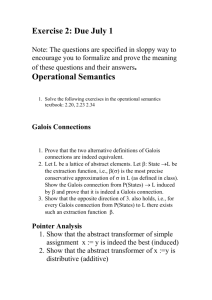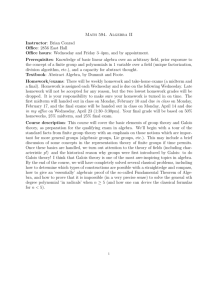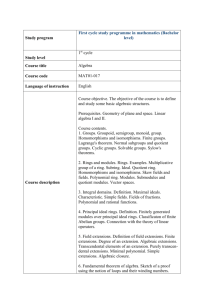Endomorphism from Galois antiautomorphism Introduction Christian Pierre
advertisement
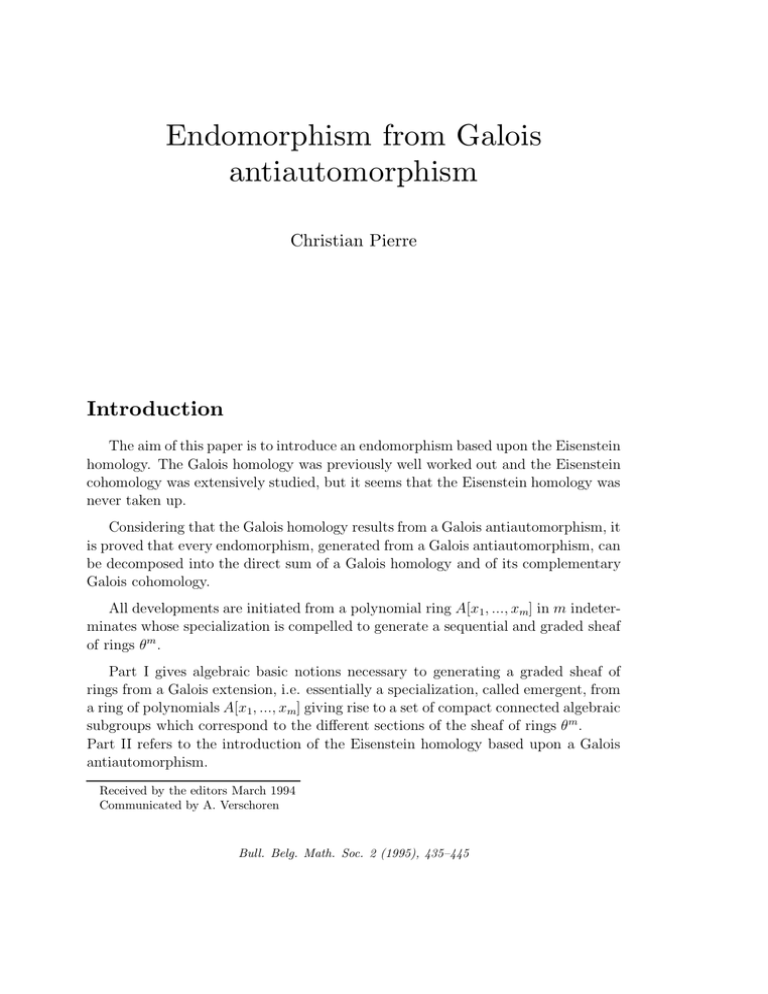
Endomorphism from Galois
antiautomorphism
Christian Pierre
Introduction
The aim of this paper is to introduce an endomorphism based upon the Eisenstein
homology. The Galois homology was previously well worked out and the Eisenstein
cohomology was extensively studied, but it seems that the Eisenstein homology was
never taken up.
Considering that the Galois homology results from a Galois antiautomorphism, it
is proved that every endomorphism, generated from a Galois antiautomorphism, can
be decomposed into the direct sum of a Galois homology and of its complementary
Galois cohomology.
All developments are initiated from a polynomial ring A[x1, ..., xm] in m indeterminates whose specialization is compelled to generate a sequential and graded sheaf
of rings θm .
Part I gives algebraic basic notions necessary to generating a graded sheaf of
rings from a Galois extension, i.e. essentially a specialization, called emergent, from
a ring of polynomials A[x1, ..., xm] giving rise to a set of compact connected algebraic
subgroups which correspond to the different sections of the sheaf of rings θm .
Part II refers to the introduction of the Eisenstein homology based upon a Galois
antiautomorphism.
Received by the editors March 1994
Communicated by A. Verschoren
Bull. Belg. Math. Soc. 2 (1995), 435–445
436
C. Pierre
Part III gives the conditions of an endomorphism generated from a Galois antiautomorphism.
1
Graded sheaf of rings from Galois extension
Preliminaries.
Let A[x1, ..., xm] be a ring of polynomials fµ [x1, ..., xm] in m indeterminates over
a field K of characteristic zero. The polynomials fµ ∈ A[x1, ..., xm] are supposed
P
to have the same general form : fµ = ri=0 aixk11 ...xkmm , where kj ∈ N, 1 ≤ j ≤ m,
k
with the same set of kj , i.e. with the same degree over each variable xj j of the
monomials ai xk11 ...xkmm . They thus only differ by the set of coefficients {ai}. Note
that this hypothesis is only required at first stage from proposition 9 in order to
define a homogeneous sequential valuation.
If fµ (α1, ..., αm) = 0, then (α1 , ..., αm) is said to be a root of the polynomial fµ
and is algebraic over K.
Definition 1. Let α = (α1 , ..., αm) be a root of a polynomial fµ ∈ A[x1, ..., xm]
supposed to be irreducible.
The specialization of the ring A is a homomorphism A0 of A into some ring from
the ring A[x1, ..., xm] with values in a field L which is a finite extension of the field
K such that the specialization of the ring A is completely determined by its kernel
p = A−1
0 (0) which is a prime ideal of A [1] or a subring of A.
Definition 2. The Galois group Γ can be defined [1] by means of a homomorphism
ν of the group K ∗ (i.e. the group of non-zero elements of K) into a totally ordered
group Γ. Such a homomorphism ν is called a valuation of K ∗ if it satisfies
ν(α + β) ≥ inf[ν(α), ν(β)],
∀α, β ∈ K ∗.
Let b1 ⊂ ... ⊂ bn be a chain of distinct prime ideals of the discrete valuation ring
B obtained under the action of the Galois group Γ.
If bi, 1 ≤ i ≤ n, is a non-zero prime ideal of B and if p = bi ∩ A, bi is said to divide
p or to be above p, written bi |p. Then, B is the integral closure of A in L and is a
free A-module of rank n = [L : K].
Definition 3. Let fµ ∈ A[x1, ..., xm] be a polynomial over a field K. An extension
field Lµ of K is said to be a splitting field over K if Lµ is generated by all the
roots of fµ . The Galois group Γµ of a polynomial fµ is the group AutK Lµ . So, we
consider the specialization A0µ of the subring Aµ of the ring A from the subring
fµ ∈ A[x1, ..., xm]. We denote by Bµ the integral closure of Aµ into Lµ (i.e. the set
of elements of Lµ which are integral over Aµ ). Then, the field of fractions of Bµ is
Lµ and the subring Bµ is a finitely generated Aµ -module.
The subring Aµ is a discrete valuation ring because it has a unique non-zero prime
ideal pµ taking its values in Lµ . Then, the subring Bµ /pµ Bµ is an Aµ /pµ -algebra of
degree nµ = [Lµ : K].
Endomorphism from Galois antiautomorphism
437
Remark 4. If we consider the specialization of the subring Aµ , the resulting prime
ideal pµ is not necessarily compact in Lm . For this reason, the specialization ATµ ,
called emergent, is introduced.
Definition 5. The emergent specialization ATµ is a specialization such that the
prime ideal pTµ be generated by the emergent morphism γµ into the two step sequence :
a) The geometric points corresponding to the roots of the splitting field Lµ are
mapped onto the origin of Lm .
b) These geometric points are then projected symmetrically from the origin of Lm
in an affine connected compact algebraic variety pTµ which is a m-dimensional
torus T m [4].
This emergent morphism γµ is completely determined by its representatives hµa =
{Pa , r(Pa ), γa } defining an abstract compact variety in the sense of A. Weil [2].
A representative hµa , where a ∈ N labels the set of geometric points, is then defined
by :
1) Pa is a point of the connected algebraic variety pTµ
2) r(Pa ) is the radius of “exjection” of a point Pa from the origin of Lm , called the
emergence point of the emergent morphism γµ (compare with the injectivity
radius of Γ\G/K introduced by De George and N. Wallach [3]).
3) γa is a one-to-one correspondence between each point corresponding to a root
and its geometrical localization on pTµ .
Lemma 6. Let Gµ be the affine algebraic group generated from all the automorphisms of the splitting field Lµ and Hµ a subgroup such that Xµm = Gµ /Hµ be the
symmetric space generated by emergent specialization.
If Pµ is a maximal connected resoluble subgroup of the algebraic group Gµ , then the
space SRµ = Pµ \Gµ /Hµ is a compact projective variety.
To the space SRµ is associated a valuation which corresponds bijectively to the radius
of exjection r(P ) of a point P ∈ SRµ .
Proof : Let K be a field of characteristic zero on which a discrete valuation ν is
defined having valuation ring Aµ . Let Zµ0 be the centralizer of G0µ (the maximal
connected compact subgroup of Gµ ) given by diagonal matrices.
Q
Then, Gµ (K) =
GLm (Lµν ) if Lµ is a finite extension of the field K.
ν
For the algebraic subgroup Hµ of Gµ , we get : Hµ =
Q
ν
Hν with :
Hν = SO(m, R) · Z0 (R) = SO(m, R) · R∗ if Lν = R
Hν = U(m) · Z0 (C) = U(m) · C∗ if Lν ' C
and Xµm = Gµ /Hµ =
Q
ν
GLm (Lν )/Hν .
Let Zµ0 (Lµ ) be the centralizer of Lµ in G0µ such that Lµ be the maximal K-split torus
438
C. Pierre
of the radical of Zµ0 (Lµ ).
Let Uµ be the unipotent radical of the parabolic subgroup Pµ0 given by the unitrigonal
group UTm (Lµ ). Then, we have the Levi decomposition Pµ0 = Zµ0 (Lµ ) · Uµ [5].
If Gµ is an algebraic group formed by unipotent matrices, Gµ is nilpotent and
can be triangularized. Furthermore, a connected resoluble group is direct product of
a maximal torus by the subgroup of its unipotent matrices, its maximal tori being
conjugated by interior automorphism. Consequently, Pµ is a resoluble subgroup of
Gµ .
ν
Let (z1 , ..., zm) be the set of coordinates of a point P ∈ SRµ and ||z||ν = |z|N
ν
where Nν is the order of valuation. Then, the height of a point P , H(P ), given by the
Q
formula H(P ) =
supi ||zi||ν [6], corresponds bijectively to the radius of exjection
ν
r(P ) of this point P . Indeed, the height H(P ) and the radius of exjection r(P ) result
directly from the emergent specialization ATµ and from the automorphism group
Γµ . Let us note that the symmetric space SRµ is also generated by an emergent
specialization since a valuation ring is always a specialization ring according to the
theorem on the extension of specializations in algebraic geometry [1].
Definition 7. Under the emergent specialization ATµ , each polynomial fµ of the
ring A[x1, ..., xm] generates a section sµ of a sheaf of ring θm on the space SRµ =
Pµ (ALµ )\Gµ (ALµ )/Hµ where ALµ is the ring of adeles.
As the subrings Aµ are discrete valuation rings, the sheaf of rings θm is quasi-compact
[7] and finitely generated according to the Mordell-Weil theorem [6].
θm is then called spec[A] and the locally ringed space (DT m , θm ) with domain DT m
is a variety scheme or a group scheme.
Remark 8. It is possible to define a graded algebra on the set of sections sµ of the
sheaf of rings θm under the action of the Galois group Γ. Indeed, consider that the
valuation refers sequentially and gradually to each section sµ as follows :
Proposition 9. Let {s1, ..., sµ, ..., sq}, 1 ≤ µ ≤ q, be the set of sections of the sheaf
of rings θm on which a sequential valuation will be introduced.
Let b1µ ⊂ ... ⊂ bnµ be a chain of distinct ideals dividing the prime ideal pTµ and denoted
bµ pTµ .
Let nbµ ∈ N be the residue degree of bµ under the Galois extension : nbµ =
[Bµ /bµ ; Aµ /pTµ ]. In the unramified case, i.e. when the ramification index ebµ = 1,
Bµ /bµ is separable over Aµ /pTµ and the degree nµ = [Lµ : K] of the Aµ /pTµ algebra
is :
Y
X
bµ
nµ =
Bµ /beµ =
nbµ .
bµ pT
µ
bµ pT
µ
Consider that the valuation operates sequentially and gradually on each section of
the sheaf of rings θm in such a way that :
1) There is a graduation on the residue degrees nbµ of each section sµ such that if nbµ
is the residue degree of the section sµ and nbµ+1 is the residue degree of the section
Endomorphism from Galois antiautomorphism
439
sµ+1 , then :
nbµ+1 > nbµ .
2) There is topological embedding between sequential sections, i.e. that s1 ⊂ s2 ⊂
... ⊂ sµ ⊂ ... ⊂ sq .
Sketch of proof : If one has that nbµ+1 > nbµ , then sµ+1 ⊃ sµ . Indeed, if r(Pµ+1 )
denotes the radius of exjection of a point P ∈ sµ+1 and if r(Pµ ) denotes the radius of
exjection of the same point P ∈ sµ , it is evident that r(Pµ+1 ) > r(Pµ ) with respect
to the sequential valuation given by the residue degrees nbµ+1 and nbµ corresponding
respectively to the sections sµ+1 and sµ .
Corollary 10. Let {s1, ..., sµ, ..., sq}, 1 ≤ µ ≤ q, be the set of sections of the sheaf
of rings θm on which a sequential valuation has been defined. Then, the q sections
of the sheaf of rings θm are generated by emergent specialization AT m if and only if
nbq > 0.
Corollary 11. Let nbµ be the residue degree of a section sµ ∈ θm . Then, the sequential residue degree of the graded sequence {s1 , ..., sq} of sections of the sheaf of
rings θm is given by the set nθm = {nb1 ..., nbµ ..., nbq } of residue degrees nbµ referring
to the sections sµ ∈ θm .
θm can then be considered as a free module with graded rank nθm = {nb1 ...,
nbq }.
2
Eisenstein homology
Definition 12. Let P (A) be the set of parabolic subgroups P (A) = {P1 (AL1 ),
..., Pµ(ALµ ), ..., Pq (ALq )} corresponding to the q sections of the sheaf of rings θm .
Let G(A) = {G1 (AL1 ), ..., Gq (ALq )} be the set of q algebraic groups corresponding
to the q sections of θm and H = {H1 (AL1 ), ..., Hq(ALq )} the set of q subgroups of G
as introduced in lemma 6.
The cohomology group H ∗ (SR, θm ) is the direct sum of the cohomology groups of
its connected components [8] given by H ∗(Γ\X m ) where X m = G(A)/H is the
symmetric space, SR = P (A)\G(A)/H and Γ = {Γ1 , ..., Γµ, ..., Γq } is a set of q
arithmetic subgroups given by P (A).
The boundary ∂ S̄R of the Borel-Serre compactification [9] i : SR → S̄R is stratified by proper parabolic subgroups P (A) such that ∂p SR be a sequential module
S
defined over K and that ∂ S̄R = P ∂p SR . As developped by G. Harder in [10], let
ΞHf be the finite set of double cosets P (Af )\G(Af )/Hf for any place f in the adele
ring A. Then, we have the following decomposition for the Eisenstein Cohomology
[11] :
H ∗ (∂p SR , θm ) = H ∗ (P (A)\G(A)/Hf , θm ) =
M
θ
H ∗ SH(ξ)
, H ∗ (ũp , θm )
m
ξ∈ΞHf
where H ∗ (ũp, θm ) is the Lie algebra cohomology referring to unipotent algebraic
group U/K with U given as usual by the set U = {U1 , ..., Uµ, ..., Uq}.
440
C. Pierre
Considering that the sheaf of rings θm is a module for the algebraic group GxK L,
after passing to the limit, it becomes a π0(G∞ )xG(Af ) module, and we get :
∞
f
∗
θ
H ∗ (∂P S, θm ) = Indπ00 (P∞
, H ∗ (ũp , θm ))
)xP (Af ) H (S
π (G )xG(A )
m
for all induced representations of the cohomology.
Definition 13. Let λµν = (λµ1 , ..., λµn )ν:K→L be an element in X(Tµm ) =
m
⊕ X(T0µ
) referring to the section sµ of θm which is
Hom(TµmxK L, GL1) =
ν:K→L
m
Tµ .
a m-dimensional torus
Similarly, let λν = {λ1ν , ..., λµν , ..., λqν } be an element in X(θm ).
Q
Considering the irreducible representation GxK L =
the sheaf of rings θm is a tensor product θm =
GLm xL =
ν:K→L
⊗ θνm
ν:K→L
Q
ν:K→L
GLm ,
= θm (λν ) where θνm is
determinated by the sequential weight λν .
Let ων = {ω1ν , ..., ωµν , ..., ωqν } be the action of the Weylgroup on λν ∈ X(θm )
and Φν = ων λν be the corresponding algebraic Hecke character [12] on θm .
Then, the Eisenstein cohomology H ∗ (∂P S, θm ) decomposes into one dimensional
eigenspaces according to a theorem of Kostant [10] :
H ∗ (∂P S, θm ) =
MM
ων Φν
∞
f
∗
θ
Indπ00 (P∞
, H ∗ (ũP , θm )(ων · λν )).
)XP (Af ) H (S
π (G )XG(A )
m
Definition 14. Let K be a field of characteristic zero, L an algebraic extension
of K and G(L/K) the corresponding Galois group. This group G(L/K) = AutK L
acts transitively on the right on the set of prime ideals b of B dividing a given prime
ideal p of the discrete valuation ring A (see definitions 2 and 3, [13] and [14]). The
ring B/pB is an A/p-algebra of degree n = [L : K].
From the Galois automorphic group G(L/K), it is possible to define a Galois
g L acting transitively on the left on the set
antiautomorphic group G∗ (L/K) = Aut
K
0
of prime ideals b of B. A subring B ⊂ B is then characterized by a descending
chain of distinct prime ideals :
bn ⊃ bn−1 ⊃ ... ⊃ bn−ρ ,
ρ<n
such that (n − ρ) be the retro-valuation degree corresponding to the considered
Galois antiautomorphism, noted antiaut.
Proposition 15. Let L be an algebraic extension of a field K of characteristic zero
and G∗ (L/K) a Galois antiautomorphic group. Then, the space ∂SR∗ , associated to
this Galois antiaut., is given by ∂SR∗ = P ∗ \G∗ /H ∗ where G∗ is the algebraic group
submitted to a Galois antiaut., P ∗ is a connected resoluble subgroup and H ∗ is a
subgroup of G∗ referring to a decreasing valuation.
Proof : The antiautomorphism given by the Galois antiaut. G∗ (L/K) leads to
consider a descending chain of ideals bn ⊃ bn−1 ⊃ ... ⊃ bη−ρ as described in definition
14.
Endomorphism from Galois antiautomorphism
441
This implies that inverse elements of the connected resoluble subgroup P have
to be considered such that P 0∗ = Z 0∗(L) · U ∗ where Z 0∗(L) is the centralizer of L in
G0∗ given by the diagonal group D(L) and where U ∗ is the inverse of the unipotent
radical U of the Galois extension L/K and is represented by the unitrigonal group
UT (M)−1 .
According to lemma 6, one has furthermore that :
H ∗ = SO(m; R) · Z 0∗ (Rν−ν ∗ )
H ∗ = U(m) · Z 0∗ (Cν−ν ∗ )
if L = Rν−ν ∗
if L = Cν−ν ∗
where (ν − ν ∗ ) refers to a decreasing valuation associated to a Galois antiaut.
Definition 16. Consider that the retro-valuation, corresponding to a Galois antiaut., operates sequentially and gradually on the sheaf of rings θm such that if (n−ρ)µ
is the residue degree of the Galois antiaut. of the section sµ and if (n − ρ)µ+1 is the
residue degree of Galois antiaut. of the sections sµ+1 of θm , then (n−ρ)µ+1 > (n−ρ)µ.
The sheaf of rings θ∗m is then characterized under a Galois group G∗ (L/K) by the
set (n − ρ)θm = (n1 − ρ1 ), ..., (nµ − ρµ ), ..., (nq − ρq )} of q difference of residue degrees
corresponding to the q sections of θm , where nµ refers to the residue degree of the
section sµ ∈ θm under a Galois extension G(L/K).
Proposition 17. Let G∗ (A) be the algebraic group generated by a Galois group
G∗ (L/K) and given by the set of algebraic subgroups : G∗ (A) = {G∗1 (A), ..., G∗µ(A), ...,
G∗q (A)} corresponding to the q sections of the sheaf of rings θ∗m .
Let P ∗ = {P1∗ , ..., Pµ∗, ..., Pq∗} be the set of q connected resoluble subgroups of the q
sections of θ∗m corresponding to a Galois antiaut. and defined in proposition 15.
Let ∂SR∗ be given by : ∂SR∗ = P ∗ (A)\G∗(A)/H ∗ .
Then, the homology group H∗ (∂SR∗ , θ∗m ) is the direct sum of the homology groups
of its connected components given by H∗ (Γ∗ \X ∗m ).
Let Ξ∗H ∗f be the finite set of double cosets P ∗ (Af )\G∗ (Af )/Hf∗ where P ∗ (Af ) is a
parabolic subgroup corresponding to a Galois antiaut.
Then, the Eisenstein homology, corresponding to a Galois antiaut., is given by
(in analogy with the Eisenstein cohomology) :
H∗ (∂P ∗ SR∗ , θ∗m ) = H∗ (P ∗ (A)\G∗(A)/Hf∗ , θ∗m )
=
M
∗m
ξ∈Ξ∗H ∗
θ
∗m
H∗ (SH
))
∗ (ξ) , H∗ (ũP ∗ , θ
f
where H∗ (ũP ∗ , θ∗m ) is the Lie algebra homology referring to unipotent algebraic
group U ∗ /K.
Proof : The proof is obvious by considering preceeding sections.
Corollary 18. Let λ∗µ(ν−ν ∗ ) = (λ∗µn , ..., λ∗µ(n−ρ))ν−ν ∗ :K→L be an element in X ∗ (Tµm ) =
m
⊕
X ∗ (T0µ
) referring to the section sµ of θ∗m . Let
Hom(TµmxK L, GL1) =
∗
λ∗(ν−ν ∗ )
=
ν−ν :K→L
∗
∗
{λ1(ν1 −ν ∗ ), ..., λµ(νµ−νµ∗ ) , ..., λ∗q(νq −νq∗ ) }
1
be an element in X ∗ (θ∗m ).
442
C. Pierre
The sheaf of rings θ∗m is then a tensor product : θ∗m =
⊗
ν−ν ∗ :K→L
∗m
∗m ∗
θν−ν
(λ(ν−ν ∗ ) ),
∗ = θ
where λ∗(ν−ν ∗ ) is a decreasing sequential weight.
∗
∗
∗
∗
Let ω(ν−ν
∗ ) = {ω1(ν −ν ∗ ) , ..., ωµ(ν −ν ∗ ) , ..., ωq(ν −ν ∗ ) } be the action of the Weylgroup on
µ
q
1
µ
q
1
λ∗(ν−ν ∗ ) ∈ X ∗ (θ∗m ) defining the corresponding algebraic Hecke character Φ∗(ν−ν ∗ ) =
∗
∗
∗m
ω(ν−ν
. Then, the Eisenstein homology H∗ (∂P ∗ S ∗ , θ∗m ) decomposes
∗ ) · λ(ν−ν ∗ ) on θ
into one dimensional eigenspaces :
H∗ (∂P ∗ S ∗ , θ∗m ) =
M
M
∗
∗
ω(ν−ν
∗ ) Φ(ν−ν ∗ )
π (G∗ )XG∗ (A )
∗m
f
∗θ
∞
Indπ00 (P∞
, H∗ (ũP ∗ , θ∗m )...
∗ )XP ∗ (A ) H∗ (S
f
∗
∗
...(ω(ν−ν
∗ ) · λ(ν−ν ∗ ) )).
3
Endomorphism from Galois antiautomorphism
group
Definition 19. Let ∂SR∗ = P ∗ (A)\G∗(A)/H ∗ be the space generated by the Galois
group G∗ (L/K) with retrovaluation residue degree (n − ρ)θ∗m applied to the sheaf of
rings θ∗m generated from an initial sheaf of rings θm of residue degree nθm . The subspace H ∗ of G∗ (A) will be defined for L = R(ν−ν ∗ ) by H ∗ = SO(m, R) · Z 0∗(R(ν−ν ∗ ) ).
The corresponding Eisenstein homology H∗ (∂P ∗ S ∗, θ∗m ) decomposes into one dimensional eigenspaces as described in corollary 18 from algebraic Hecke characters
∗
Φ∗(n−ρ) = ω(n−ρ)
· λ∗(n−ρ) .
Let ∂SR(I) = PI (A)\GI (A)/HI be the space complementary of ∂SR∗ and corresponding to a Galois group GI (K/L) conjugated to the Galois group G∗ (L/K), as
resulting from the definition 14 of a Galois antiautomorphism.
The complementary automorphic space ∂SR(I) will be characterized by a sequential
residue degree ρI counted from the sequential retrovaluation residue degree (n − ρ).
The subspace HI of GI (A) will parallely be defined for L = R by HI = SO(m, R) ·
ZI0 (R).
The Eisenstein cohomology H ∗ (∂P SI , θIm ) corresponding to the generation of this
complementary space ∂SR(I) will also decompose into one dimensional eigenspaces
as described in definition 13 and will be characterized by complementary algebraic
Hecke characters ΦρI = ωρI · λρI .
Proposition 20. Every smooth endomorphism of an algebraic group G(A) on an
automorphic space ∂SR of Galois group G(L/K) with residue degree n can be generated by means of a Galois antiautomorphism and can decompose into the direct
sum of two connected algebraic groups G∗ (A), corresponding to a Galois antiaut.
of group G∗ (L/K), and GI (A), which is a complementary algebraic group of G∗ (A)
and subgroup of G(A) given by a Galois extension of group GI (L/K).
We then have the following decomposition for the smooth endomorphism Et [G(A)] :
Et [G(A)] = G∗ (A) ⊕ GI (A)t
Endomorphism from Galois antiautomorphism
443
satisfying the conditions:
1) The subgroups H ∗ ⊂ G∗ (A) and HI ⊂ GI (A) are such that the groups SO(m, R),
from which they are defined, must have the same witt index (i.e., the same rank)
but different orders.
2) The Eisenstein homology H∗ (∂P ∗ S ∗ , θ∗m) and cohomology H ∗ (∂P SI , θIm ), associated respectively to G∗ (A) and GI (A), are varying oppositely in such a way that
H∗ (∂P ∗ S ∗ , θ∗m ) “generates” H ∗ (∂P SI , θIm ) according to the following equality on algebraic Hecke characters :
Φ∗(n−ρ) = CH (ρ) · ΦρI
where CH (ρ) is a set of q parameters CH (ρ) = {CH1(ρ1 ), ..., CHµ(ρµ )...
CHq (ρq )} depending on the proper valuation ρ and measuring the variation in sequential degrees of ΦρI , related to H ∗ (∂P SI , θIm ), in function of Φ∗(n−ρ) , related to
H∗ (∂P S ∗ , θ∗m ).
Proof :
1) The fact that every endomorphism Et [G(A)] (compare with the standard definitions of endomorphisms [15]) of an algebraic group G(A) can decompose into the
direct sum of an algebraic group G∗ (A), corresponding to a Galois antiaut. G∗ (L/K)
and of its complementary algebraic group GI (A)t, which is a subgroup of G(A) and
thus an ideal of the affine variety given by G(A), results from the definition of a
Galois antiaut. given in definition 14.
2) The groups SO(2p, R) ∈ H ∗ ⊂ G∗ (A) and SO(2p + 1, R) ∈ HI ⊂ GI (A)t have
the same rank p but different orders given by m = 2p or m = 2p + 1 respectively.
Indeed, if the groups SO(m, R) had the same order, this should mean that the map
Et [G(A)] would be the identity map and that (G∗ (A) ⊕ GI (A)t) would not be more
the direct sum of two distinct connected algebraic groups G∗ (A) and GI (A)t but
would define a unique connected algebraic group G(A).
3) The fact that the spaces ∂SR∗ and ∂SR (I) are defined respectively by means of the
groups SO(2p, R) ∈ H ∗ and SO(2p+1, R) ∈ HI with different orders results directly
from the reduction steps of Hilbert irreducibility theorem [16] applied to the ring of
polynomials A[x1, ..., xm]. Indeed, via the Kronecker’s specialization, this theorem
tells us that a ring of irreducible polynomials in m variables can be reduced to a
ring of irreducible polynomials in n variables where n < m.
4) According to the Hilbert’s irreducibility theorem, it is obvious that the groups
SO(2p, R) ∈ H ∗ and SO(2p + 1, R) ∈ HI need not have peremptorily the same rank
but this is a prerequisite in order that there is not a breakdown of the endormophism
Et which is then called “smooth”.
5) The equality Φ∗(n−ρ) = CH (ρ) · ΦρI results directly from the definition of the algebraic Hecke characters Φ∗(n−ρ) and ΦρI and from the definition of the endomorphism
Et [G(A)].
Note that the set of parameters CH (ρ) is the most closed to the unity {1, ..., 1, ..., 1}
∗
when the degree of retrovaluation on the sheaf of rings θm
is equal to the degree of
m
valuation of its complementary sheaf θI .
444
C. Pierre
Corollary 21. If the reduced algebraic group G∗ (A) and its complementary algebraic group GI (A), obtained from the algebraic group G(A) by smooth endomorphism, are not connected, the smooth endomorphism E[G(A)] will be introduced :
E[G(A)] = G∗ (A) ⊕ GI (A)
such that the subgroups SO(m, R) ∈ H ∗ ⊂ G∗ (A) and SO(m, R) ∈ HI ⊂ GI (A)
have the same ranks and the same orders. Then, there exists a unique emergent morphism γ which maps the sheaf of rings θIm from the space δSR(I) = PI (A)\GI (A)/HI
⊥
into its orthogonal complement δSR(I)
on which is defined the resulting complementary orthogonal sheaf θIm⊥ .
Proof : As the origin OS is the unique point of intersection between the space Σ∗R =
⊥
∗
⊥
∂SR∗ ∪ OS and its orthogonal complement Σ⊥
R = ∂SR ∪ OS , i.e. that OS = ΣR ∩ ΣR ,
⊥
the envisaged morphism γ from ∂SR(I) to ∂SR(I) may be decomposed in the two step
sequence :
1) mapping of the sheaf of rings θIm onto OS , called the emergence point of the
morphism γ.
⊥
2) Projection of θIm from OS into ∂SR(I)
such that ρθIm⊥ = {ρ1 , ..., ρµ, ..., ρq} of
the q sections of the complementary orthogonal sheaf θIm⊥ be conserved, i.e. that
ρθIm⊥ = ρθIm . This morphism γ is an emergent morphism according to definition 5,
and thus, is unique.
References
[1]
A. Weil, Arithmetic on algebraic varieties, Ann. of Math. 53 (1951) 412-444.
[2]
A. Weil, Foundations of algebraic geometry, Amer. Math. Soc., Colloq. Publ.
29 (1946).
[3]
D. De George, N. Wallach, Limit formulas for multiplicities in L2 (Γ\G), Ann.
of Math. 107 (1978) 133-150.
N. Wallach, Limit multiplicities in L2 (Γ\G), Lect. Not. Math. 1447 (1990)
31-56.
[4]
A. Borel, J. Tits, Groupes réductifs, Publ. Math. IHES 27 (1965) 54-151.
[5]
R. Langlands, On the functional equations satisfied by Eisenstein series, Lect.
Not. Math. 544 (1976) 1-320.
Harish-Chandra, Automorphic forms on semi-simple Lie groups, Lect. Not.
Math. 62 (1968) 1-130.
[6]
S. Lang, A. Néron, Rational points of abelian varieties over function fields,
Amer. J. Math. 81 (1959) 95-118.
[7]
J.P. Serre, Faisceaux algébriques cohérents, Ann. of Math. 61 (1955) 197-278.
Endomorphism from Galois antiautomorphism
445
[8]
A. Borel, Stable real cohomology of arithmetic groups, Ann. Scient. écol. norm.
sup. 7 (1974) 235-272.
[9]
A. Borel, J.P. Serre, Corners and arithmetic groups, Comment. Math. Helv. 48
(1973) 436-491.
[10] G. Harder, Eisenstein cohomology of arithmetic groups, the case GL2 , Invent.
Math. 89 (1987) 37-118.
G. Harder, Some results on the Eisenstein cohomology of arithmetic subgroups
of GLn , Lect. Not. Math. 1447 (1990) 85-153.
[11] J. Schwermer, Cohomology of arithmetic groups, automorphic forms and Lfunctions, Lect. Not. Math. 1447 (1990) 1-29.
[12] L. Clozel, Représentations Galoisiennes associées aux représentations automorphes autoduales de GL(n), Publ. Math. IHES 73 (1991) 97-145.
[13] A. Douady, Cohomologie des groupes compacts totalement discontinus, Sém.
Bourbaki 189 (1959-60) 1-12.
[14] J.P. Serre, Local fields, Grad. texts in Math. 67 (1979) 1-237.
[15] A. Corner, On endomorphism rings of primary abelian groups, Quart. J. Math.
Oxford 20 (1969) 277-296.
M. Dugas, R. Göbel, On endomorphism rings of primary abelian groups, Math.
Annal. 261 (1982) 359-382.
[16] D. Hilbert, Über die Irreduzibilität ganzer rationaler Funktionen mit
ganzähligen Koefficienten, J. Reine Angew. Math. 110 (1892) 104-129.
Christian PIERRE
Clos des Gaulois 15
B1340 OTTIGNIES
